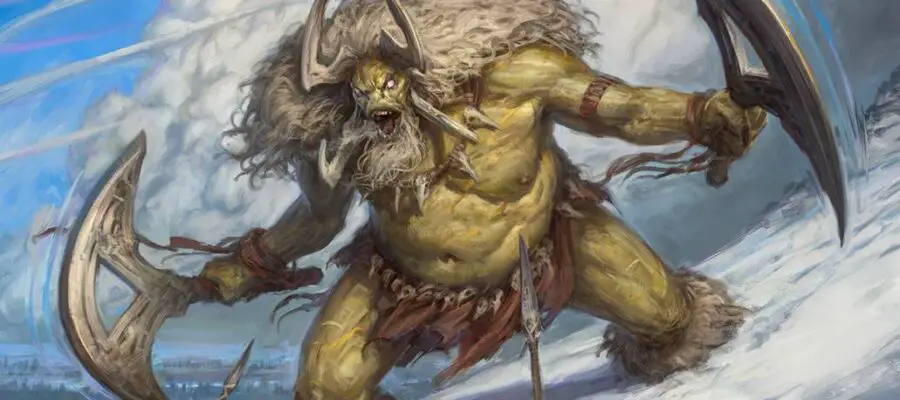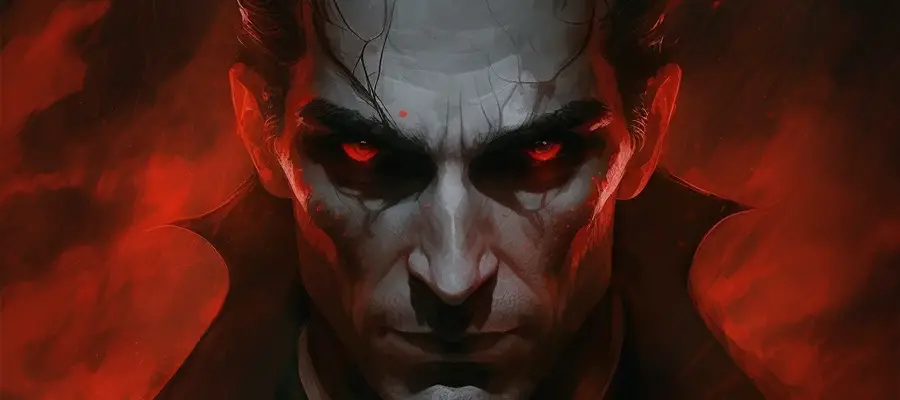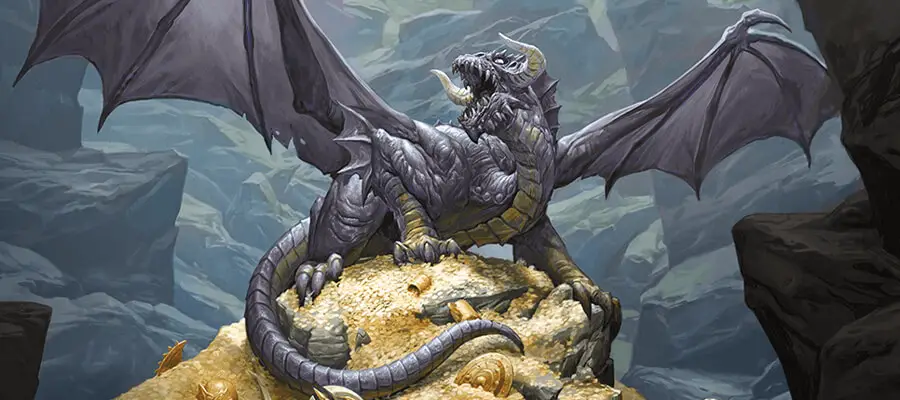“Enraged Chieftain” by 000Fesbra000, Creative Commons Attribution-Noncommercial-No Derivative Works 3.0 License.
This article contains affiliate links that add gold to our coffers.
The boss fight is a quintessential RPG experience. Adventurers’ adrenaline pumps are in hyperdrive as they approach an expected boss fight. The players have been looking forward to this battle for weeks… or have they? Let’s talk about boss fights to make sure your players are hooked every time.
Bosses are often involved in the main plot or in an important point of character development, but they’re enjoyable even as frivolous, powerful guardians of random dungeons delved. If a boss fight is done well, it doesn’t matter how poorly it fits into the story; the players will love the experience and talk about for the rest of their lives. Because boss fights are so essential, I’m going to dissect what it takes to make them great, and I’ll share tips from my own repertoire.
I’ll be sharing principles, not rules. Nothing I say is meant to be absolute. As Jack Sparrow would say, they’re more like guidelines. Principles sound like rules, but experienced story crafters know when they can ignore a particular principle. Additionally, I’m sticking to broad advice related to boss battles; I won’t be talking about how to craft a supreme villain, plan a story climax, or generally balance fights with the CR system. We’re focusing on the boss fight itself. Let’s get started!
Jump Ahead:
Pre-Battle
The Battle Itself
Role Playing
Atmosphere and Theater
Gridded Maps and Miniatures
Post-Battle
Pre-Battle
Build Up / Foreshadow
Many boss fights fall short because stakes are not raised throughout the journey to the battle. Foreshadowing goes a long way in building hype. If your boss fights involves a hag that transforms her enemies into misshapen abominations, plant some grotesque creatures along the road for the players to discover, like a squirrel with a fungal infection, a wolf with a hunchback and weeping wound, or a tree that has bark of waxy consistency dripping from it. If a red dragon awaits the players, allow the players to find scorched tableaus of the dragon’s former foes on the walls. If you’re building up to a fight with a rich aristocrat, leave a thematic foreshadowing event for the players; for example, if the adventure involves colonists invading a tribe’s land, show the players a bird’s nest that is being usurped by another bird.
Allow the party to be joined by a powerful ally for the first time. If they’ve interacted with a captain of the guard or a quirky hermit, reward their role playing with alliances that matter in battle. Players love to see NPC’s make themselves useful without being condescending to the party, so give them what they want! The meta-knowledge of the DM allowing allies will make the players think they’re in for a battle that is truly challenging.
Prior Encounter
If foreshadowing is too subtle, you could allow the party to meet the boss ahead of time. Maybe the boss shows their force through a heinous act like executing an NPC that the players care about. The Curse of Strahd D&D adventure does this well. Consider introducing the boss in a dream sequence, where true power is revealed but stakes are relatively low, but make sure it’s clear that it’s a dream (no surprise ‘wake up!’ when the fight is over).
Examples of a villain’s early show of force:
- Negan (The Walking Dead)
- T-800 (The Terminator)
- Thanos (Avengers: Infinity War)
- Captain Harrison Love (The Mask of Zorro)
Scouting and Intel
Provide opportunities for your party to learn about a villain’s lackeys, abilities, traps, weaknesses, etc. This can be done through my previous pre-battle tips. Another method to inform and prepare is to allow interrogations and questionings of minions that actually yield results. Interrogations are often a waste of time as the players end up torturing some poor sod while the DM refuses to give up details. Just give the players some information and call it good.
If a player does some slick roleplaying or bribes the right person, give them heaps of information; you’ll make them the hero of the night amongst your players, and they’ll feel great. You might also allow the snoopy rogue to discover a journal, letter, or other written reveal belonging to the boss or a chief officer of the boss. This is an excellent way to reward exploration while also enriching your own preparations as it highlights the boss, the minions (by name, rank, quirk, etc.), and anything else you crafted. Basically, get into the mindset to liberally dispense information to parties that even slightly seek it out, and you’ll have a good time.
The Battle Itself
Action Economy
Legendary Actions can make a mundane, out-of-the-manual boss fight into an engaging thunderdome that makes players fear for their characters’ lives. Lair Actions are similarly important as they make the players feel like they’re in a deadly, unpredictable situation. These types of actions are perfect for boss fights. If you just send a single Beholder against a party (particularly if they don’t have headroom to fly out of reach), it’s likely that they’ll just focus down the Beholder in two or three rounds. Don’t let this happen! Instead, read about the Beholder’s Lair Action list and utilize it. Give the Beholder some custom Legendary Actions if the Lair Actions feel insufficient.
Homebrewing Legendary Actions and Lair Actions is encouraged. Very few low-level monsters are designed to have them in the Monster Manual, so create your own! Matt Colville has a video (link) about this topic that is worth a listen if you want to design custom boss monsters for your game. Pick a theme for a monster (big hits, minion empowerment, battlefield control, etc), then give it new abilities and actions that add to its action economy. Maybe a goblin warlord significantly buffs the goblins around him, or a necromancer empowers undead within his lair.
Most of all, if the boss is a genius, let him do genius things like threaten the PC’s loved ones, or use minions to coralle the party into position to be slammed by an area-of-effect spell. The boss should be the boss for a reason. If intelligence and cunning aren’t in the wheelhouse of your set-piece villain, at least give them opportunity to demonstrate feats of physical strength or of whatever their skillset may be.
Minions
Use smaller monsters that fight with your boss monster! Minions will make a fight much more interesting, and incredibly more fun to describe since players will likely mow down minions in a grand juxtaposition to the boss that just won’t die.
If it’s daunting to run so many monsters in a boss fight, you can use the concept of minions from former D&D editions which make minions into 1-hit-point creatures since the party should easily defeat them. They can still do formidable damage (or little damage if you like), but the point is to make them instantly die when they take damage. This will prevent a fight from getting bogged down, and the players will feel more powerful than ever as they cleave foes that used to be threats.
There’s a chance that players will think you’re nerfing monsters because you think they can’t handle them. Just explain the 1-hitpoint-monster concept and I promise they’ll be fine. The worst that could happen is they ask you to just use the full monsters stats because they want a challenge.
Role Playing
Memorable Dialogue
Write down memorable dialogue ideas so you don’t forget them, but don’t feel like you must use them. You might write down full sentences or just words and phrases that a character would use, particularly for battle banter. I’ve also recorded my voice with a sound manipulating app to make my voice sound more like a Beholder or a Mind Flayer.
Epic Narration
D&D is a power fantasy, so describe it that way. When a player scores a critical hit or finishes off a foe, describe it epically. If your players are up to it, let them describe their kills in as much detail as they like. Just don’t make them do rolls to see if they can coup de gras the way they described because it slows combat down and will often needlessly deflate their power fantasies.
If you don’t feel skilled in narrating violence, rely on your players to do it. If neither of you want to do it, don’t worry about gore; instead, use epic dialogue, even if it’s corny. Occasionally you’ll strike gold and have a memorable quote and inside joke with the game group.
To improve your narration, look up some cool adjectives and verbs that go with your players’ abilities and monsters’ anatomies so that you are prepared with interesting descriptions. Don’t be afraid to steal ideas from popular fiction that you enjoy (a lot of D&D is plagiarism of ideas anyway). Go big with your descriptions because there shouldn’t be anything holding you back from indulging in grandiose, epic narration.
Named Abilities (Anime Style)
Declare names of your monsters’ abilities when used (like a proper anime technique). Matt Mercer, DM of Critical Role, employs this effectively when he says a monster will use its [insert intimidating title] as his players gasp and wonder what will happen. It’s more fun to give monsters abilities with appropriate names if you actually share the names with your players, even if it feels like meta-gaming. Embrace your inner anime protagonist and shout those attack names!
Atmosphere and Theater
Ambience
Prepare music that you don’t usually use, haven’t used before. Change music at different combat phases. Change up the lighting when you start the encounter, such as dimmed lighting or lamps throughout the room. It might even be cool to burn a candle or incense that have appropriate scents. Just think about how you can delight your players’ senses beyond just describing a situation.
Be dramatic about rolling initiative, but get it out of the way quickly. Boss fights often begin when tension is high, but initiative rolls and establishing turn orders can diffuse the hard-earned tension if you’re not careful. If you are still working on a combat tracking system that works for you, ask your players to help track damage dealt to monsters, play battle music, and whatever else you need help with that won’t distract them from their own characters’ turns (because you want those to go quickly too).
Sub-goals and Preoccupations
Fights are simple to understand, but they become tricky for players to navigate when there are other problems to solve during a fight. For example, the boss could have a general riding away on horseback with a message that the players need to intercept, meaning they need to both win the battle and catch up quickly. The players may also have to protect a nobleman that is ill-suited to violence. Time limits may also put your players on edge, such as if a room is filling quickly with water and only the enemies can survive without oxygen. You may need to set up these scenarios ahead of time so your players can prepare, but definitely to make them care.
Gridded Maps and Miniatures
Encourage Focus
If your players can’t visualize the fight, they’ll probably disengage a bit (unless you are supremely talented with theater of the mind). I highly recommend you give them a physical battle map and a miniature for the boss that can become the focal point for your party’s collective aggression. Prepare the map before the session so you can just bring it into the room when battle begins.
Cheap Visuals
I’ve mentioned this before, but I highly recommend getting cheap miniatures so you can have a battle map that isn’t composed of whatever is laying around the room. I get cheap miniatures from arcade ticket prizes, Amazon deals on old miniatures from games like HeroClix, and all kinds of random places. I keep my eclectic collection of cheap game pieces in a box, and it has grown into a fun assortment of options over the years. Start collecting random minis now if you haven’t already, and I promise they’ll help your boss battles to be memorable.
Of course you can buy and paint professional, stunning miniatures, but there’s a lot more time and money that goes into it. If you plan on being in this hobby for a long time and you have the storage space, start buying generic minis that can be your base collection of ambiguous goblins, knights, bats, etc. Players enjoy a battle map before their eyes, so give them what they want so they can stay engaged.
Terrain
I’ve had my share of boss fights that occur in an ambiguous room or an inconsequential open area. I recommend you craft combat terrains that are more interesting, dangerous, and tactical. This is especially important for fringe game choices, such as spells that aren’t normally chosen. If your players focus on optimal spells when they learn or prepare them, they may be disappointed when they need a less-picked spell like Pyrotechnics or Water Walk. If you have a player that doesn’t normally shine because their spell choices are not thus-far handy, plan encounters that will enable them to deploy their suboptimal abilities.
Terrain ideas:
- Dim light or complete darkness, masking the hidden movements of ninjas in a room of assorted mannequins or grove of thick trees.
- Crowded public area.
- Narrow switchbacks on a cliffside, including a deadly fall for any creature unfortunate to tumble off the edge. Don’t use this if you’re not willing to have characters fall and possibly die instantly.
- Wilderness Hazards found on page 110 of the DMG:
- Quicksand
- Desecrated Ground
- Frigid Water
- Razorvine
- Slippery Ice
- Thin Ice
- A body of water limits movement as archers rain arrows down from the far side. This is deceptively devastating if the boss monster has a spell like Control Water to create a whirlpool.
- Burning piles of wood can rage to obstruct movement and billow smoke that inhibits visibility.
- Water towers with weak bases can be chopped down with a mighty swing to topple on to enemies.
- Bear traps hidden under leaves for flat-footed oafs can be devastating to players who need to move in quickly. (Hunting Traps found on page 152 of PHB)
- Force the players to climb a tall ladder to reach the foe, effectively becoming sitting ducks for archers’ pot shots and brutes’ falling boulders.
- Crevices that require swinging over a rope or crossing a destructible bridge.
Post-Battle
Loot
A boss fight is only as good as the loot that follows! If the players’ have beheld the boss and its minions using magical, ornate weapons and items, make sure the player can scavenge those items after dispatching said villains. Riches will do if magical items aren’t in the stars, but make sure players have chances to spend wealth down the road.
The Dungeon Master’s Guide holds a plethora of magical items, though homebrewing items tailored for your PC’s will dazzle them. To stretch your creativity for crafting magical items, check out our guides on the subject:
- Rules and methods for magic item crafting.
- Enable players to create magic items.
- Incorporate formulas for crafting magic items in-game.
- Guide to crafting magic items.
Stick the Landing
Just like a gymnast, you must stick the landing or your boss fight will be a fleeting moment in your players’ D&D history. Once the fight is over, don’t allow the energy to stagnate by abruptly turning off the music and strangely ceasing to move the game forward. Chances are your players think it’s time to go home at this point and they’ll start disengaging from the game if you seem to be taking it easy. Just like swinging a baseball bat, you gotta follow-through on the swing to land a homerun. It helps to visualize the party emerging victorious so you can script out narration if it suits the moment. This is also a great time to inform players that they can level up before next session.
Conclusion
I’m sure this article has given you inspiration and much to think about for how to improve your boss fights; I know I learned a lot collecting my thoughts and experiences for you. Planning an adventure to build up a villain is so rewarding, especially if you plan details that improve player focus, instill a sense of ambience, and challenge the party with disadvantageous situations. Visualize the ending and reward your players liberally. Hone your craft with these principles and you’ll do just fine.
What tips did I miss? Please comment with your ideas and experiences and I’ll try to respond promptly. I am not joking when I say we at Flutes Loot love receiving comments and emails from our readers, so don’t be shy. Thanks again for reading! I’ll leave some links to other DM tips if you want to press on exploring without a short rest:



